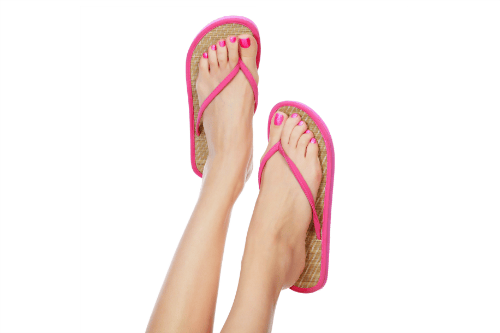Flip flops and strappy sandals are warm-weather staples.
But are your tootsies in tip-top shape or are they woefully tender and callused?
It’s that time of year and you’ve probably been wearing sandals or flip-flops this summer – and sometimes all year round if you live in a warmer climate.
With that in mind, you may have noticed that you’ve developed extra calluses or corns on your feet.
The constant flapping and friction of flip-flops against your heels have probably caused rough, dry calluses to form.
Or, if you’ve been wearing strappy sandals, you may have noticed painful corns on your toes where the straps have rubbed against them.
Corns and Calluses are annoying, thick, hardened layers of skin that form due to friction and pressure against the skin.
The skin may be dry, flaky, or waxy looking.
Calluses can vary in size and shape and they are not usually painful unless they develop cracks, which can become quite sore.
Corns and calluses are technically the same – a hard, thickened area of skin – but they show up on different parts of your feet. Calluses can form in various places, such as the heels, toes or balls of the feet – but corns typically develop on bony areas of the feet, particularly over joints or in between toes.
Although irritating and sometimes unattractive, corns and calluses also serve a purpose and are the body’s defense mechanism.
The body produces callus material to protect itself from irritation.
Prevention is really the goal. It’s much harder to deal with the problems after they’ve developed.
Check out these simple tips for dry, callused and cracked heels to help maintain soft, smooth and cuddly feet:
Regular Professional Pedicures not only feel great, but they also help maintain the health and well-being of your feet.
Lotion, lotion, lotion! Hempz lotions and cremes are a personal favorite to moisturize not only your feet, but your entire body as well.
Use of a pumice stone or pedi-file to keep calluses smooth in between pedicures is always a good idea. Both are available in different grits and can be used wet or dry and should be sanitized on a regular basis to avoid bacteria build up.
Paraffin Treatments not only add extra oils to moisturize both hands and feet, but are also beneficial for sore joints and muscles.
Applying moisturizer and putting socks on in the evening just before bed is a great way to help your feet absorb and maintain the moisturizer throughout the night. If your feet tend to get overheated in the middle of the night with socks on like mine do, there are “pedi sox” with open toes for “ventilation” that can be purchased on-line.
NO razor blades PLEASE! Otherwise known as the credo blade and banned in Arizona, they are used to quickly shave off calluses.
Unfortunately, with this method, often times too much callus is removed potentially causing injury and infection.
Thought to be a “quick fix”, the callus tends to grow back thicker and faster after just a few short days.
The most important tip of all. Be kind to your precious feet…..you will not get too far without them!
